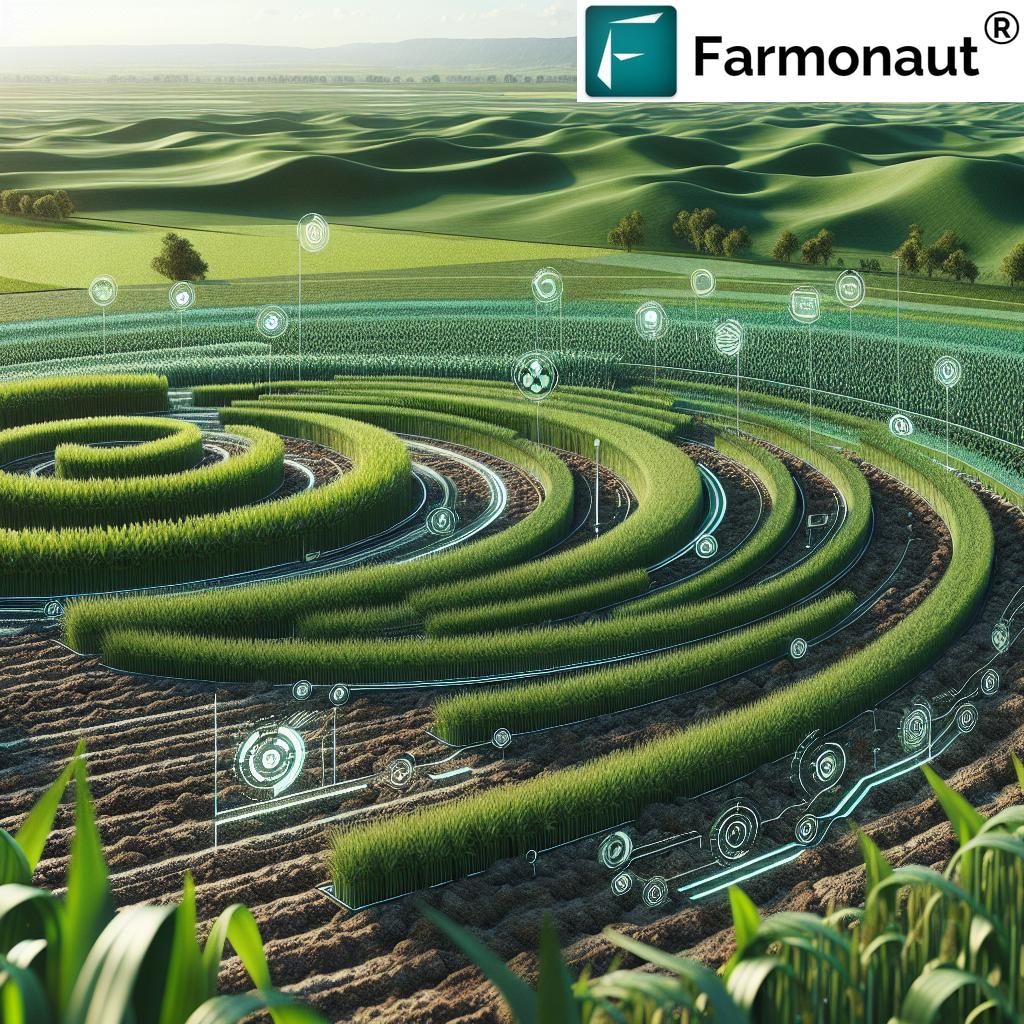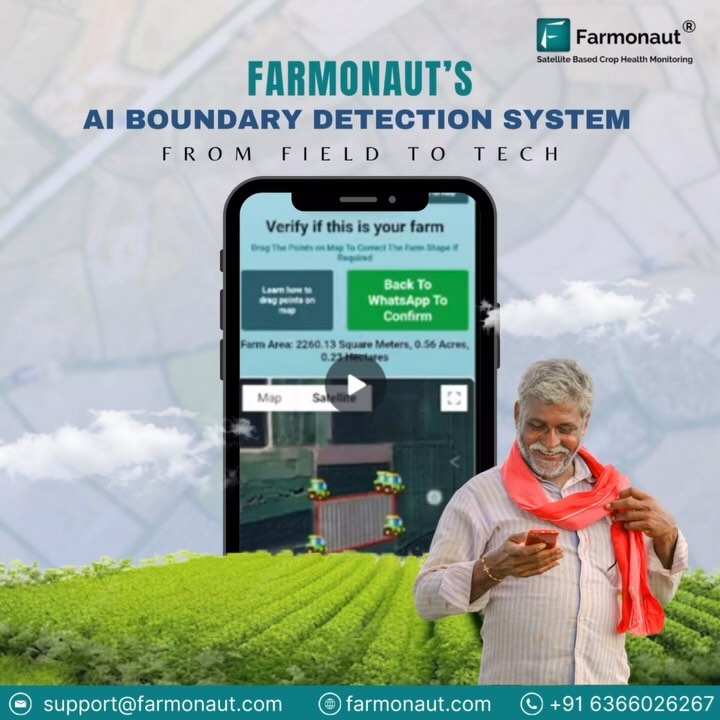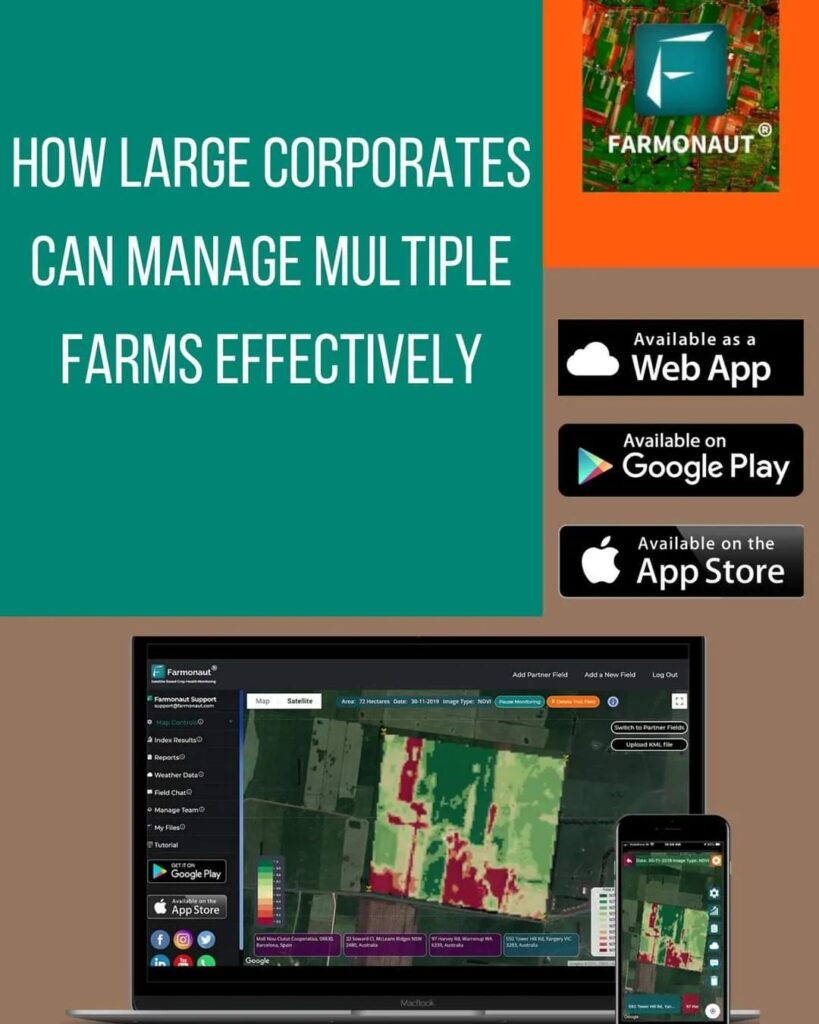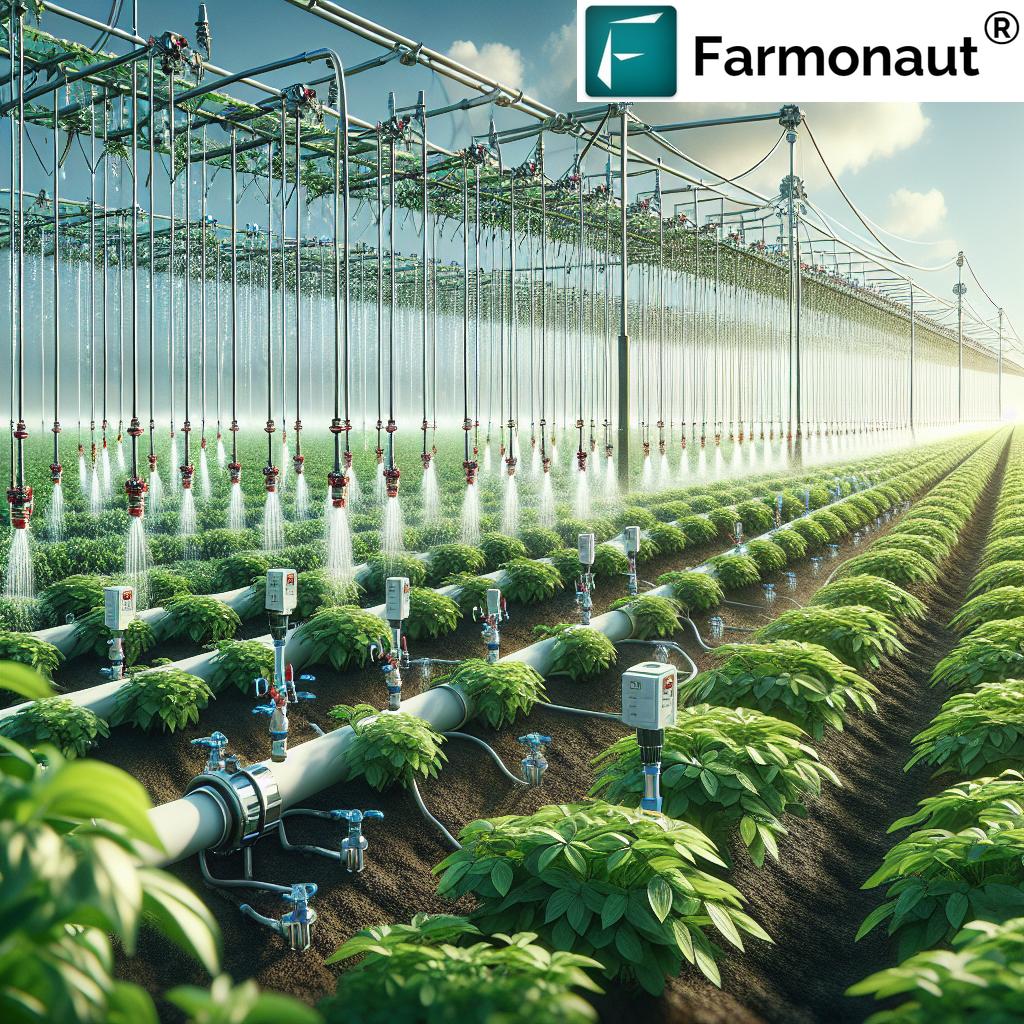
Preventing Blossom End Rot: Organic and Conventional Solutions for Fruit Growers
As agricultural technology experts at Farmonaut, we understand the challenges faced by fruit growers, especially when it comes to common physiological disorders like blossom end rot. In this comprehensive guide, we’ll explore the causes, symptoms, and solutions for this prevalent issue, combining traditional wisdom with cutting-edge satellite technology to help growers protect their crops and maximize yields.
Understanding Blossom End Rot
Blossom end rot is a physiological disorder that affects various fruits, most commonly tomatoes, peppers, eggplants, and squash. It’s characterized by a dark, sunken, and leathery patch at the blossom end of the fruit, opposite the stem. This disorder is not caused by a pathogen or pest, but rather by a complex interplay of environmental factors and nutrient deficiencies.
The Role of Calcium
At the heart of blossom end rot is a calcium shortage within the developing fruit. Calcium is crucial for cell wall development and stability in plants. When there’s insufficient calcium available to the growing fruit, the cells at the blossom end begin to break down, leading to the characteristic symptoms of blossom end rot.
Factors Contributing to Calcium Deficiency
- Inconsistent watering (too much or too little)
- Rapid plant growth due to excessive nitrogen fertilization
- High soil salinity
- Root damage
- Extreme temperatures
- Low soil pH
It’s important to note that blossom end rot is not always a result of low calcium levels in the soil. Often, the issue lies in the plant’s inability to transport calcium efficiently to the developing fruits.
Identifying Blossom End Rot
Early detection is key to managing blossom end rot effectively. Here are the signs to look out for:
- Small, water-soaked spots on the blossom end of the fruit
- Spots enlarging and darkening to a brown or black color
- Affected areas becoming sunken and leathery
- In severe cases, secondary infections by fungi or bacteria can occur
While traditional scouting methods involve regular visual inspections of the crop, modern technology offers more efficient solutions. At Farmonaut, we leverage satellite imagery and AI to detect early signs of plant stress that could indicate the onset of blossom end rot.
Farmonaut’s Satellite Monitoring: A Game-Changer in Early Detection
Our advanced satellite monitoring system at Farmonaut provides growers with a powerful tool for early detection of potential blossom end rot issues. Here’s how our technology compares to traditional methods:
| Aspect | Traditional Methods | Farmonaut’s Satellite Monitoring |
|---|---|---|
| Detection Method | Visual inspection by walking through fields | High-resolution satellite imagery and AI analysis |
| Speed | Time-consuming, especially for large areas | Rapid, covering entire fields in minutes |
| Accuracy | Subject to human error and oversight | Highly accurate, detecting subtle changes in plant health |
| Cost-effectiveness | Labor-intensive and costly for large operations | Economical, with scalable solutions for farms of all sizes |
| Early Intervention | May miss early signs, leading to delayed response | Enables proactive measures before visible symptoms appear |
By utilizing Farmonaut’s satellite monitoring system, growers can identify potential calcium deficiencies and water stress issues early on, allowing for timely interventions to prevent blossom end rot.
Prevention and Control Strategies
Addressing blossom end rot requires a multifaceted approach. We’ll explore both organic and conventional methods to help growers maintain healthy crops throughout the growing season.
Soil Management
- Soil Testing: Regular soil tests are crucial to monitor calcium levels and pH. Farmonaut’s satellite data can complement soil testing by providing insights into overall field health.
- pH Adjustment: Maintain soil pH between 6.0 and 6.5 for optimal calcium uptake. Use lime to raise pH if necessary.
- Organic Matter: Incorporate compost or well-rotted manure to improve soil structure and nutrient retention.
Calcium Supplementation
While adding calcium to the soil can help, it’s often more effective to focus on improving calcium uptake and distribution within the plant.
- Foliar Sprays: Apply calcium chloride or calcium nitrate sprays directly to the foliage and developing fruits.
- Soil Amendments: Incorporate gypsum or bone meal into the soil before planting.
- Balanced Fertilization: Avoid excessive nitrogen, which can promote rapid growth at the expense of calcium uptake.
Water Management
Consistent moisture is crucial for calcium transport within the plant.
- Irrigation Scheduling: Use Farmonaut’s satellite-based soil moisture data to maintain consistent soil moisture levels.
- Mulching: Apply organic mulch to conserve soil moisture and regulate temperature.
- Drip Irrigation: Consider installing drip irrigation systems for more precise water delivery.
Cultural Practices
- Variety Selection: Choose cultivars less susceptible to blossom end rot.
- Plant Spacing: Ensure proper spacing to reduce competition for nutrients and water.
- Pruning: Remove excess foliage to improve air circulation and reduce transpiration stress.
Organic Solutions for Blossom End Rot
For organic growers, there are several natural approaches to preventing and managing blossom end rot:
- Eggshell Calcium: Crush and incorporate eggshells into the soil or create an eggshell tea for foliar application.
- Seaweed Extract: Rich in micronutrients, seaweed extracts can improve overall plant health and stress resistance.
- Compost Tea: Brew compost tea to provide a balanced nutrient boost and beneficial microorganisms.
- Cover Crops: Plant calcium-accumulating cover crops like alfalfa or clover in the off-season to enrich the soil.
- Rock Phosphate: A slow-release source of calcium that also provides phosphorus.
Conventional Approaches to Blossom End Rot Control
For those using conventional methods, there are additional options available:
- Calcium Nitrate Fertilizers: Apply as a side-dress or through fertigation systems.
- Chelated Calcium Products: These formulations improve calcium absorption and translocation within the plant.
- Growth Regulators: Some synthetic plant growth regulators can help improve calcium distribution in fruits.
- Hydroponic Solutions: For greenhouse growers, carefully balanced nutrient solutions can prevent calcium deficiencies.
Leveraging Technology for Blossom End Rot Prevention
At Farmonaut, we believe in harnessing the power of technology to enhance crop management and protection. Our satellite-based solutions offer several advantages for growers dealing with blossom end rot:
- Early Warning System: Our AI-powered analysis can detect subtle changes in plant health that may indicate the onset of calcium deficiency or water stress.
- Precision Agriculture: By providing detailed field maps, we enable growers to apply targeted treatments only where needed, reducing costs and environmental impact.
- Historical Data Analysis: Track field performance over time to identify patterns and optimize management practices.
- Integration with Weather Data: Our system combines satellite imagery with local weather forecasts to help growers make informed decisions about irrigation and calcium applications.
To learn more about how Farmonaut can help you manage blossom end rot and other crop health issues, visit our application page or explore our API services for custom integrations.

Case Studies: Success in Managing Blossom End Rot
While we don’t provide specific case studies, our experience working with growers worldwide has shown that a combination of traditional wisdom and modern technology can significantly reduce the incidence of blossom end rot. Growers who have adopted Farmonaut’s satellite monitoring system report earlier detection of potential issues and more targeted interventions, leading to healthier crops and improved yields.
The Future of Blossom End Rot Management
As agricultural technology continues to advance, we anticipate even more precise and effective methods for managing blossom end rot and other physiological disorders. Some promising areas of research include:
- Development of more resistant cultivars through genetic engineering and traditional breeding
- Advanced sensor technologies for real-time monitoring of plant nutrient status
- Precision application systems for targeted delivery of calcium and other nutrients
- AI-driven predictive models for blossom end rot risk assessment
At Farmonaut, we’re committed to staying at the forefront of these developments and incorporating new advancements into our platform to better serve growers worldwide.
Conclusion
Blossom end rot may be a common challenge for fruit growers, but with the right knowledge, tools, and strategies, it’s a manageable one. By combining time-tested agricultural practices with cutting-edge technology like Farmonaut’s satellite monitoring system, growers can significantly reduce the incidence of this disorder and improve overall crop health and productivity.
Remember, successful management of blossom end rot requires a holistic approach that considers soil health, water management, nutrient balance, and environmental factors. Regular monitoring, early intervention, and adaptive management practices are key to maintaining healthy, productive crops throughout the growing season.
For growers looking to take their crop management to the next level, Farmonaut offers a range of solutions tailored to farms of all sizes. Our mobile apps are available for both Android and iOS devices, providing on-the-go access to critical crop health data.
For developers and agribusinesses interested in integrating our satellite and weather data into their own systems, we offer comprehensive API services. Check out our API documentation for more information.
FAQs About Blossom End Rot
- Q: Can blossom end rot spread from one fruit to another?
A: No, blossom end rot is not contagious. It’s a physiological disorder, not a disease caused by pathogens. - Q: Is it safe to eat fruits affected by blossom end rot?
A: While unappealing, the affected part can be cut away, and the rest of the fruit is safe to eat if it’s ripe. - Q: How quickly can blossom end rot develop?
A: Symptoms can appear rapidly, often within a few days of fruit set, especially during periods of rapid fruit growth. - Q: Can overwatering cause blossom end rot?
A: Yes, both overwatering and underwatering can contribute to blossom end rot by affecting calcium uptake and distribution in the plant. - Q: Are some crops more susceptible to blossom end rot than others?
A: Yes, tomatoes, peppers, eggplants, and squash are particularly prone to blossom end rot. - Q: How often should I apply calcium supplements to prevent blossom end rot?
A: The frequency depends on your specific situation. Generally, foliar sprays can be applied weekly during fruit development, but always follow product instructions and consult with a local agricultural expert. - Q: Can mulching help prevent blossom end rot?
A: Yes, mulching can help maintain consistent soil moisture, which is crucial for proper calcium uptake and distribution. - Q: Is blossom end rot more common in container-grown plants?
A: Container-grown plants can be more susceptible due to limited soil volume and potentially more frequent fluctuations in soil moisture. - Q: Can high temperatures increase the risk of blossom end rot?
A: Yes, high temperatures can increase transpiration rates and affect calcium distribution within the plant, potentially leading to blossom end rot. - Q: How can Farmonaut’s technology help me prevent blossom end rot?
A: Our satellite monitoring system can detect early signs of plant stress and provide insights into soil moisture levels, helping you take proactive measures to prevent conditions that lead to blossom end rot.
By staying informed and utilizing the latest agricultural technologies, growers can effectively manage blossom end rot and other challenges, ensuring healthy crops and bountiful harvests. At Farmonaut, we’re here to support you every step of the way.













